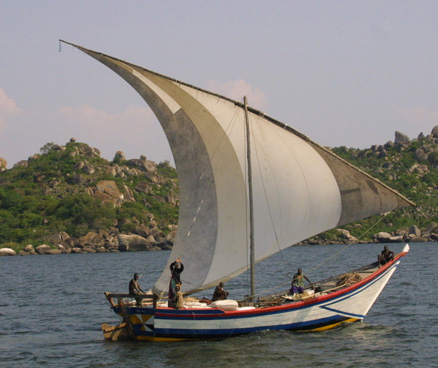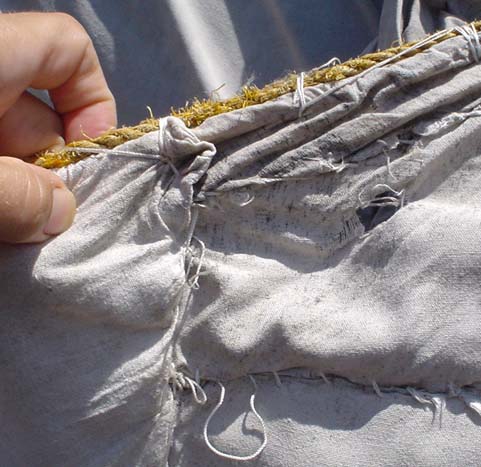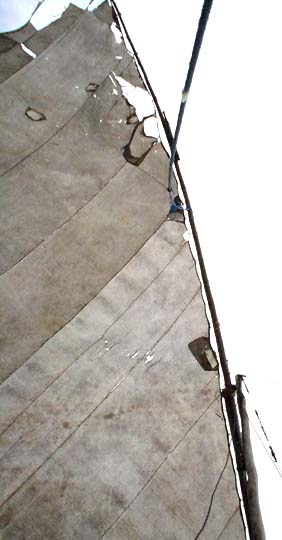
| Greetings Home |
| Previous Greeting |
| Next Greeting |
| Previous Dhow Logbook |
| Next Dhow Logbook |
Crtd 05-01-01 Lastedit 15-10-27
The Best
Yard in Town
(Mwanza trip 2)
For my second trip I went with my cross motorcycle on a cargo ferry from Kampala to Mwanza. Due to problems with the port immigration authorities I had to drive back along the lake's East coast, crossing al borders illegally (for the details of this story, click: Illegal). On arrival, I found a captain willing to take me for a short trip, showing the sailing procedure.

Photo:
dhow of about half the size ordered (with a better sail than the one that took
me for a trip)
More photo's
On inspection, the sail looked unlike the ones Europeans are used to. They are made of cotton tissue of the type used for bed sheets, the stitching is by hand and not of the quality used locally for making clothes..

Elsewhere, I found sails
made of 50 kg bags from the cane sugar factories. Those are made of chemical
yarns, far stronger but the wind is blowing right through it.
Once raised, the sail turned out to be torn thoroughly.

The trimming of the ship, however was done very well, and it sailed lightly and unexpectedly fast

Needless to add, the boat is open, apart from a steering deck (on which the owner of the feet on the picture sits) under which the firewood for the stove (a car wheel mounted on a tire) is kept dry, and where one can sleep (since the wind never comes from the front).
Having learned from our
previous mistake to select not only on hardware and technique, but also on
people, we went into another week of
negotiations and technical conversations with the two shipyards that we
considered the serious alternatives to the one we abandoned. Taking time makes
it easier to see who is more accurate with agreements to meet and prepare data,
and who is willing to show trust and longer term commitment by taking a share in
the burden of financing and to work before pay.
Daniel, a young guy who formerly was down on our list, turned out to be the Best
Yard In Town. He understood our ideas and came with good suggestions of his own.
He turned out to have a production on his yard bigger by far than that of the
others (mostly much smaller dhows, though). Jeremia, formerly skeptical about
his technical abilities, now got very pleased with him. Jeremia did not always
understand Daniels calculations, and neither did I. Dhows are not built
following a drawing. The size of every part follows from the keel length chosen
and is determined by the eye or by proportional comparison. I worked
with a computer drawing derived from some photographs and counting lengths and
little squares of a grid as
input for a spreadsheet. We seemed not to be far apart.
I could not wait until the settlement of the final agreement, had to return to
Jinja (see
Illegal).
At home, I was called about a technical subject: I had chosen for a length of
15 m, that of the largest dhow I had seen, but yet this one was not big enough to yield
standing headroom for me (1.86 m) in the cabin under the deck. So my basic
design size was relatively slightly high dhow. I did not tell Daniel, and thought
he would not notice or at least not bother much. But he found it and since he knew the standing
headroom requirement he suggested to keep the dhow in traditional proportion,
hence 30% longer. The Largest Dhow On The Lake. Now he was the one to
come with the idea, which I had
considered and not dared to propose, I concluded he had the courage, and if he had, I should
have it too.
His price went up proportionally to US$ 13 000,- . That is ridiculously low for
a hard wood boat of 20 meters, but an undreamt fortune in East Africa.
The next step would be to buy the wood, which would, it was claimed at first,
imply sending one of the shipyards employees Ahmed, who was also a
mninga
trader, to the forest with the equivalent of US$ 10 000.
I protested. I had never seen this Ahmed. He could be robbed from his money or
say so. He could be robbed from his wood or say so. Money OK, but for wood that
had arrived on the yard. Even if it would cost me 10% more, I claimed, it would
be a fair insurance cost.
We ended up with advancing 30%. End of February.
Daniel had logs for a keel, I heard, and had started making it.
Then the waiting for the wood set in. March. First message: bad weather in the
forest, no way to get logs out. Second message: unfortunately no
mninga
available at present.
My email how long is Ahmed now in that forest with my US$ 3000??
I was calmed down: this is normal, such things happen.
April: some wood found in another forest, but we need more money.
More money? If there is no wood, where is the bloody US$ 3000 advance money?
The increase of the advance was refused but I was still advised to wait.
But the combination of a trader unknown to me with a lot of money "in the
forest" for more than two months without getting a single piece of wood out, and
a request for more money made clear to me that the time of waiting was over.
| Greetings Home |
| Previous Greeting |
| Next Greeting |
| Previous Dhow Logbook |
| Next Dhow Logbook |